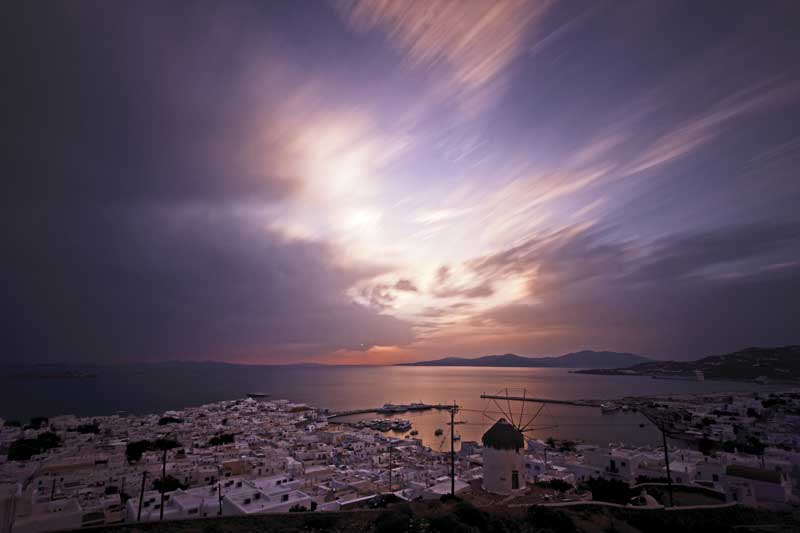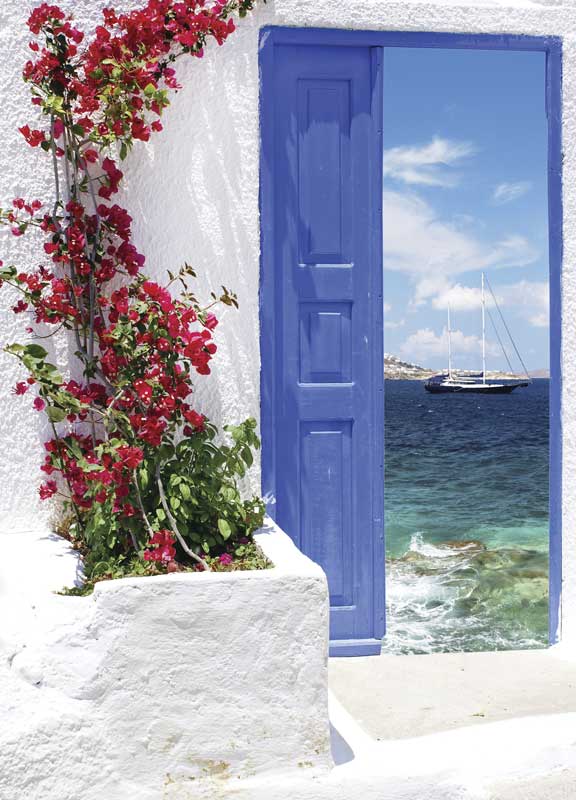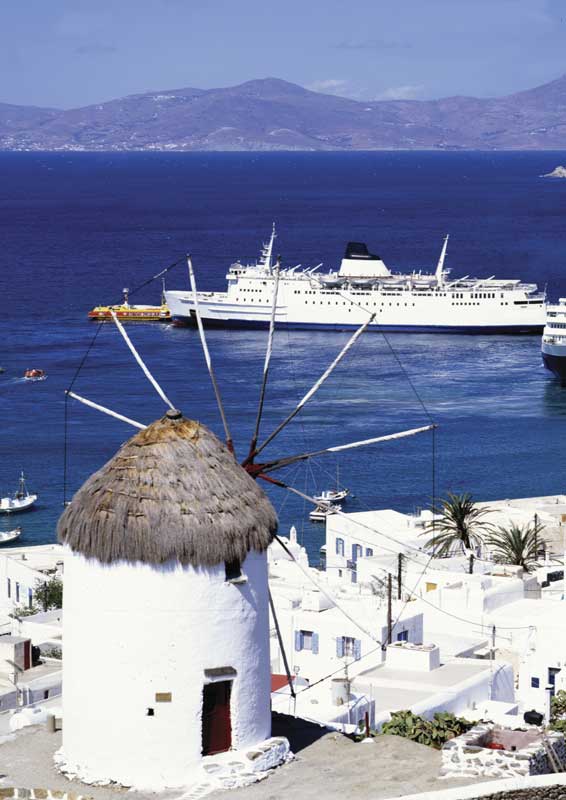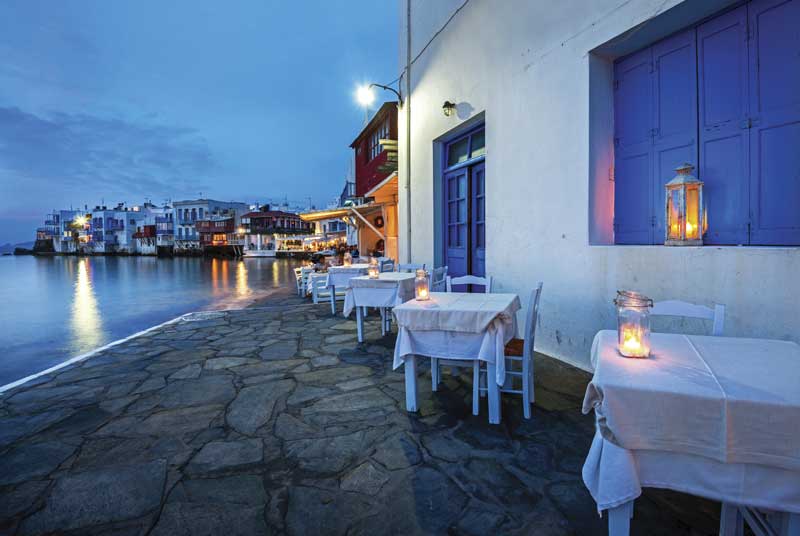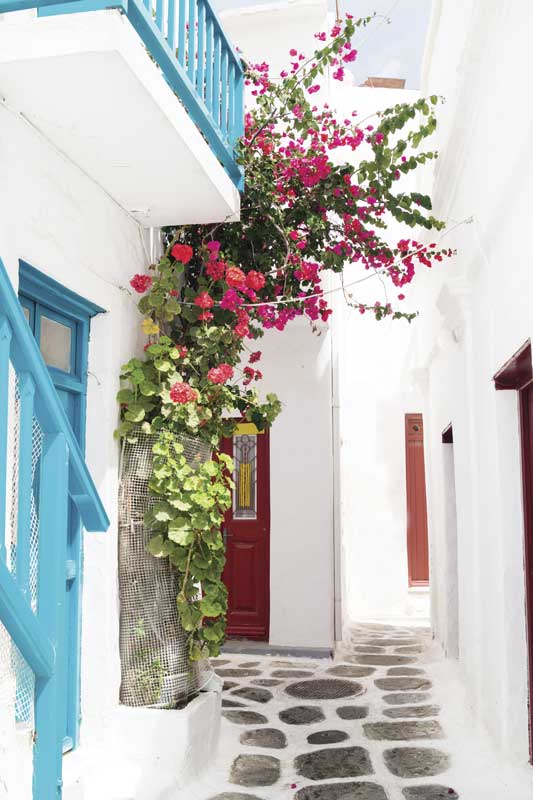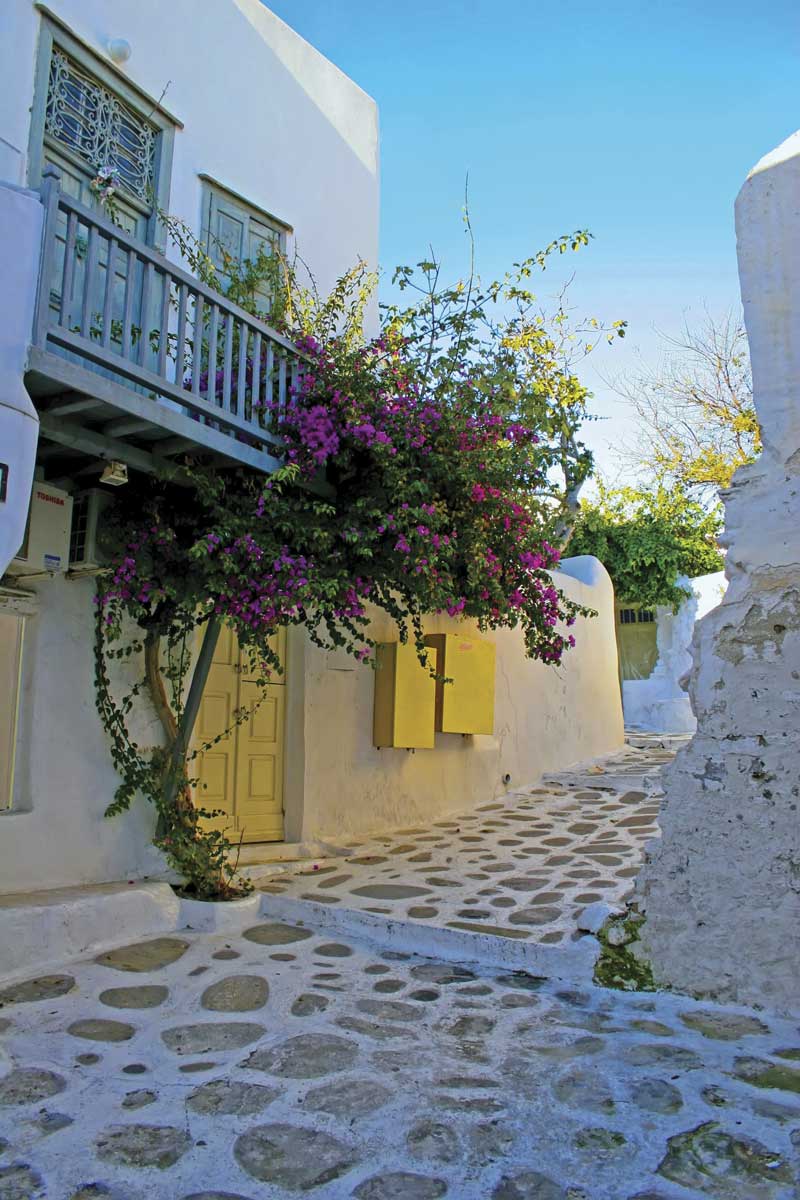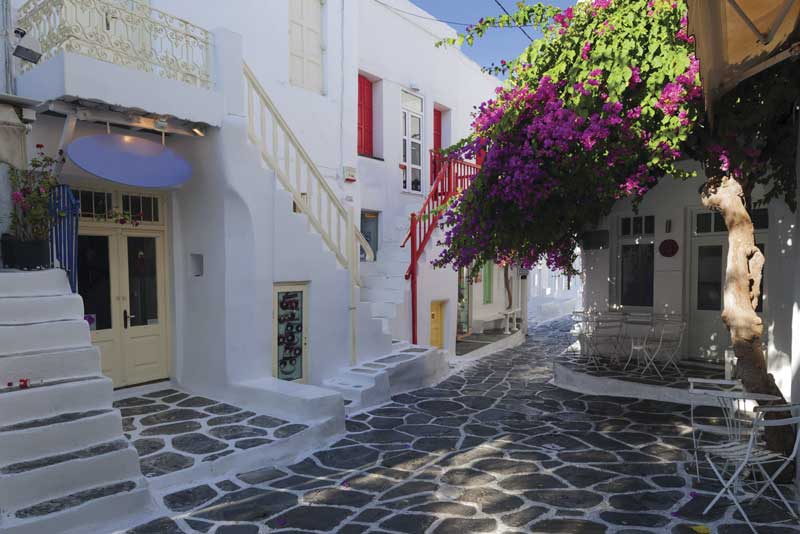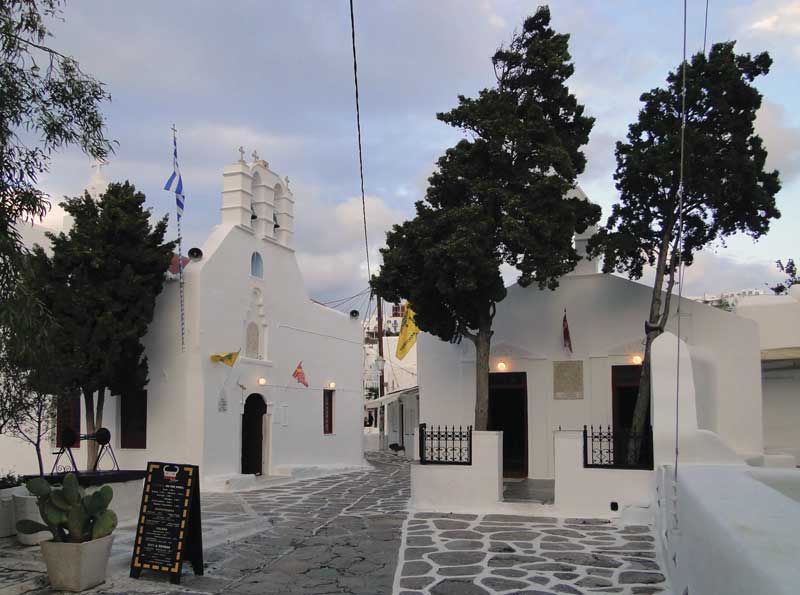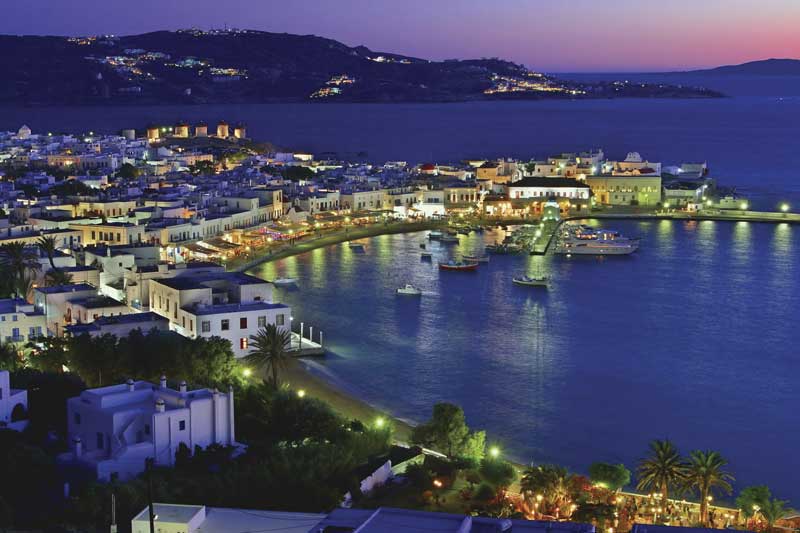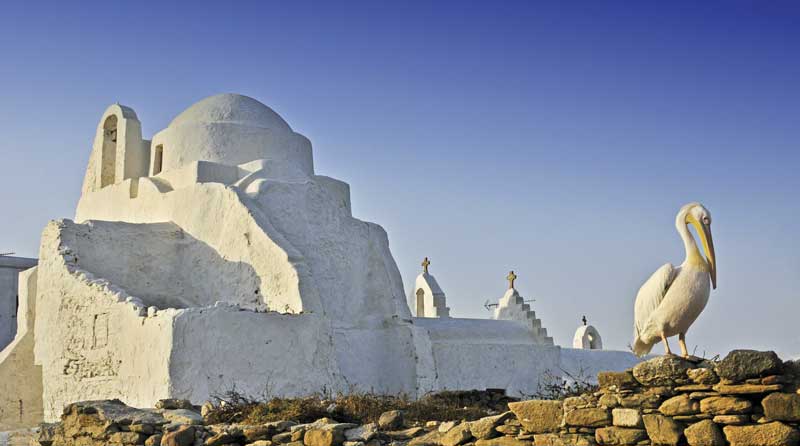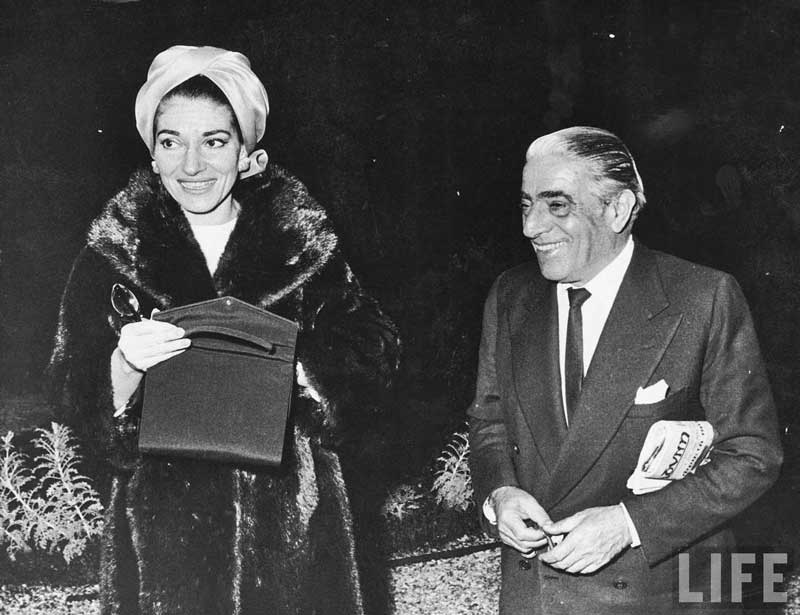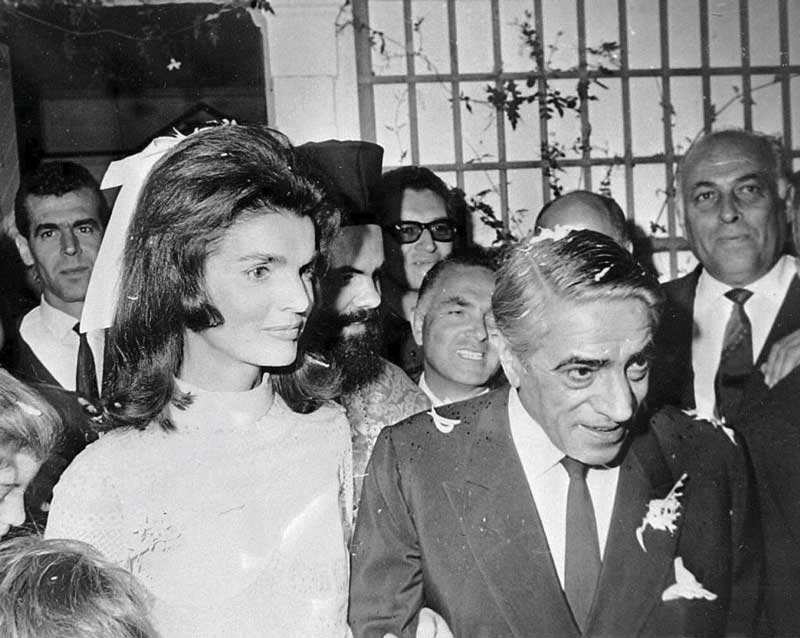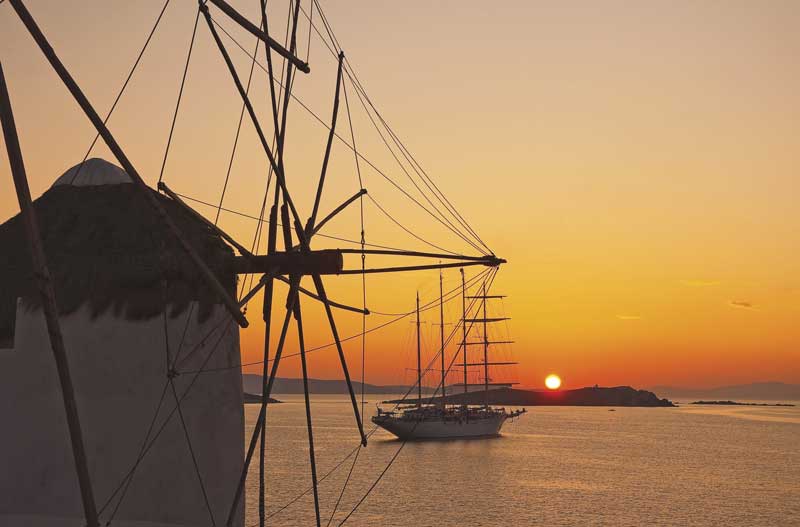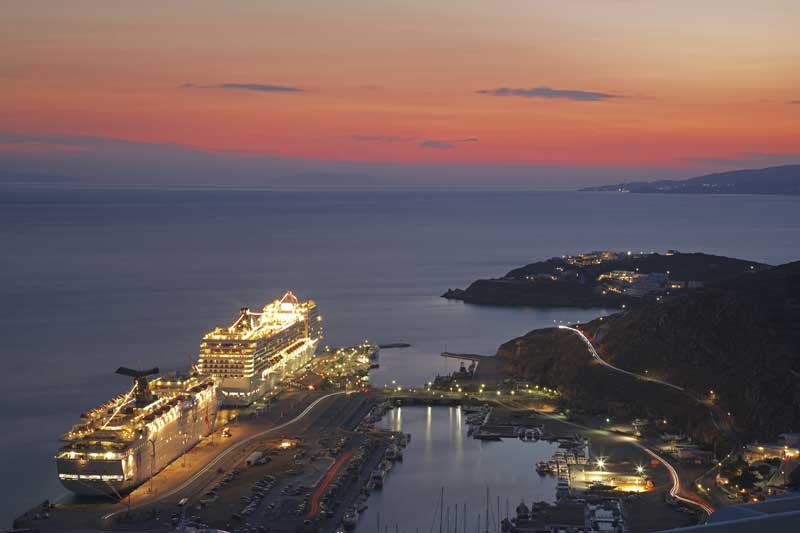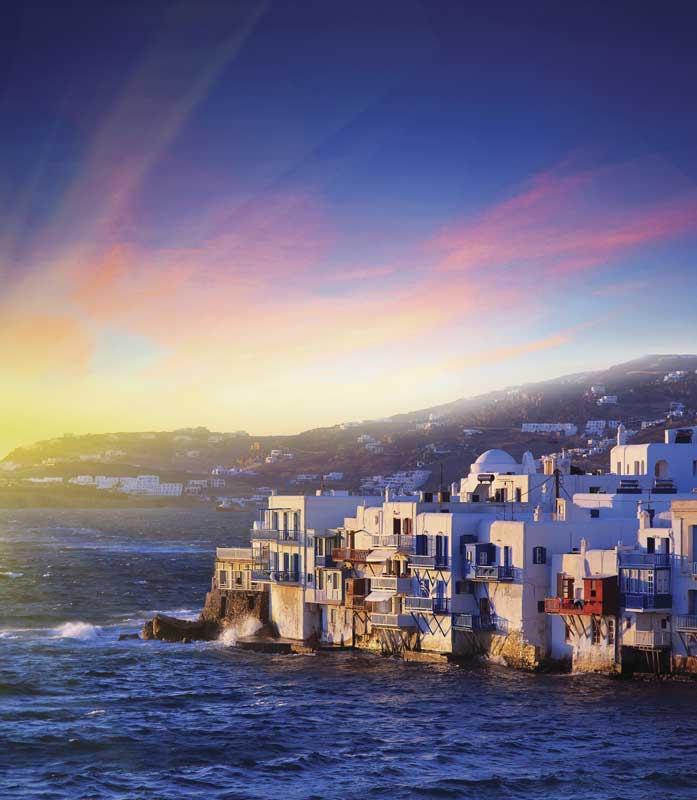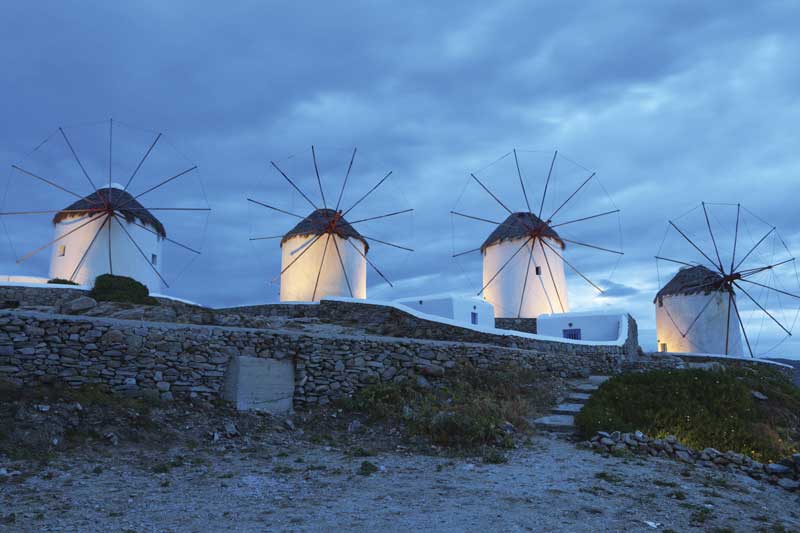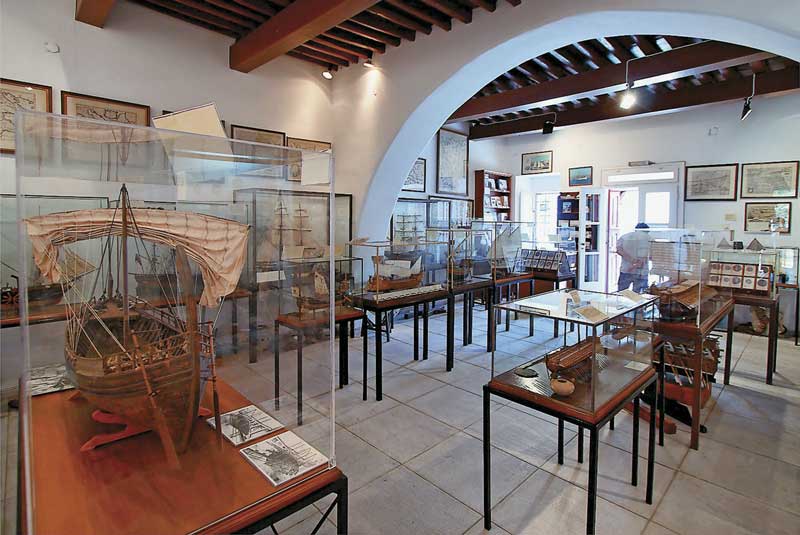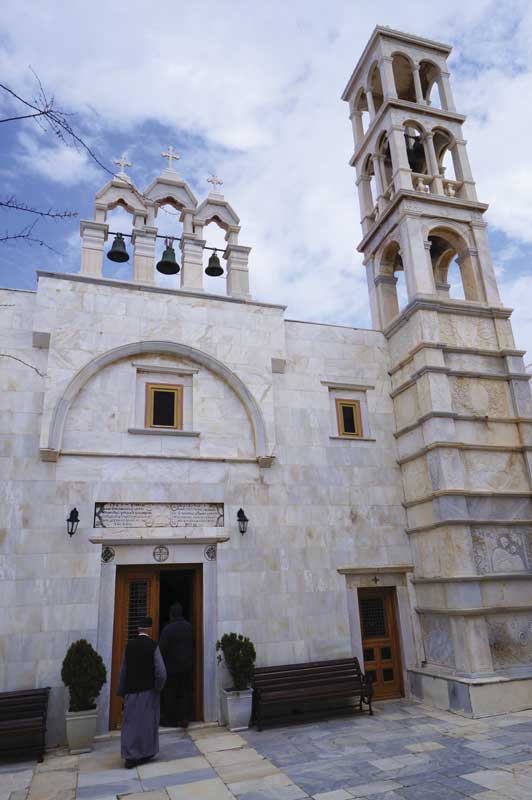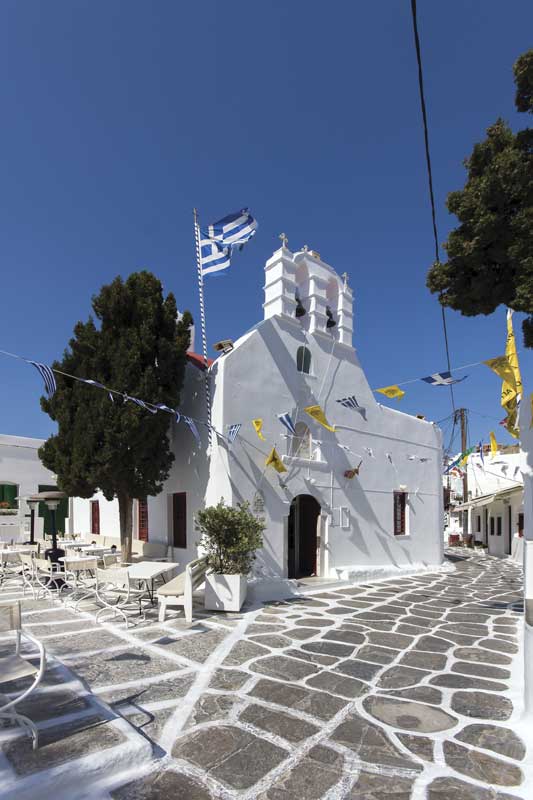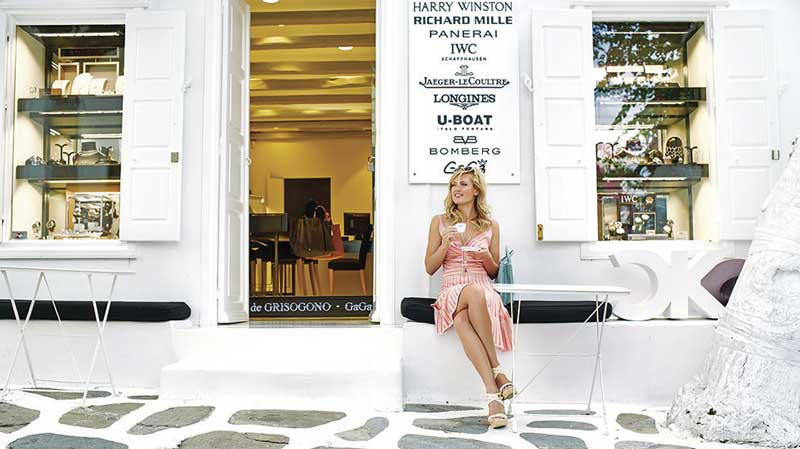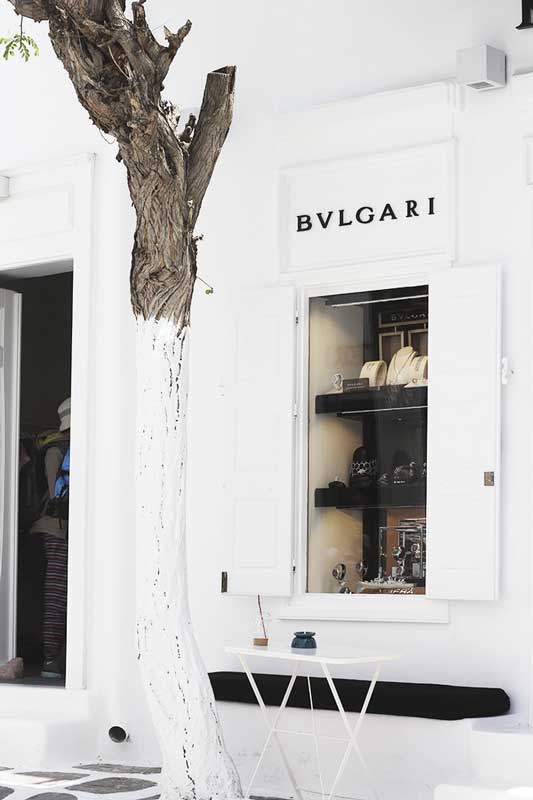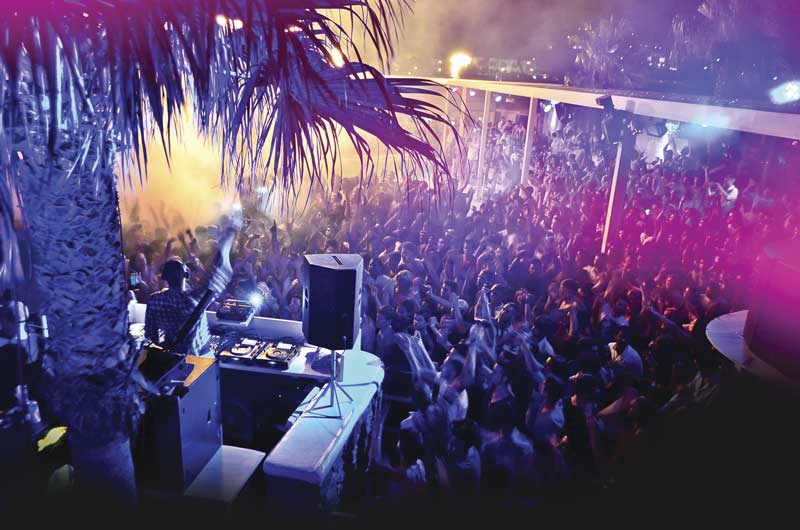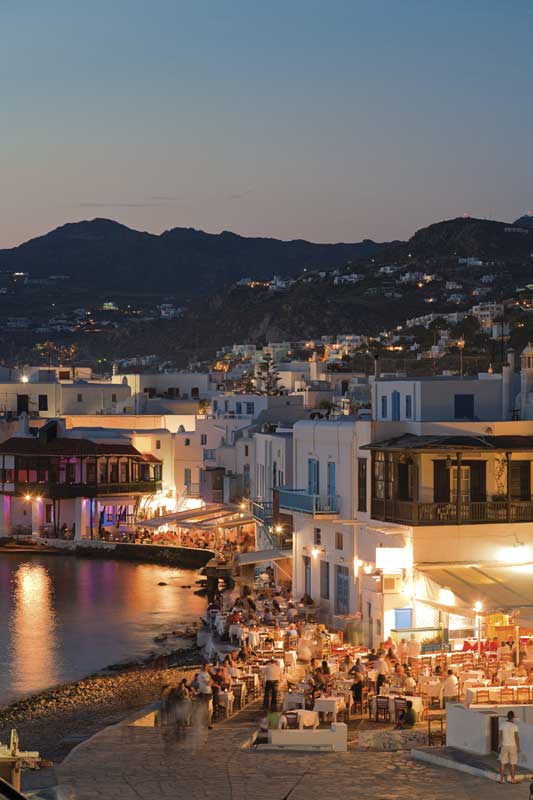The Cyclades Islands: the Birth of Western Civilization
The Cyclades Archipelago is comprised by a collection of charming and powerful islands, surrounded by sea and full of mystery. They hosted a crucial period of development for the Greek nation and its legacy around the world: the Cycladic civilization (Copper and Bronze Ages, Cyclades, Aegean Sea, 3000 BC to 2000 BC). Our journey takes us specifically to three of them: Mykonos, Delos and Kea. Prepare the ships! Their ports await.
“Love consists on feeling the Sacred One beating inside the loved one."
Plato
MYKONOS The Core of the Aegean Sea
Mykonos is the Island of Light because of Apollo. In mythology, the island is tied to Apollo because he is the one who gifted the islands with their greatest qualities: light, beauty, poetry and music. It is the Island of the Winds as well because of the untamed strength—during certain terrible moments—of the Meltemi winds, which are more frequent during July and August. The constant presence of these winds in the coasts cleanses the air so that it remains unpolluted and transparent. It is the Pearl of the Cyclades, the Island of Wonders; there are many other ways, all flattering, to call it. It is the home of many love stories. It is the perfect balcony from which you can observe the many amazing colors that enthrall the soul with the light of the sunrise and the sunset. If you visit this island you will be able to explore archeological sites, museums, art galleries, countless sand beaches and waters the color of sapphire to revel in the pleasures of sailing, swimming, sunbathing, water-sports, and also horse-riding and hiking to discover the island’s most secret locations.
You can relish in the delicious gastronomy, the intensity of the nightlife, the most exclusive spots, boutiques with a great variety of clothing, jewelry and other accessories that have always attracted celebrities and personalities from all over the world. The island was rediscovered in the 50s, when the first luxury yachts and cruise ships docked at the ports. The influx of visitors has grown exponentially due to Mykonos’s reputation as a high-level destination.
The island’s inhabitants keep their souls humble and open, and they reside mostly in Chora (in Greek it means capital city)—a maze of streets that is said to have been planned that way because of the pirates; the streets were meant to confuse the intruders. This city is a beautiful collection of permanently white houses. Their balconies are decked with flowers that, along with the doors, windows, and stairs, provide a multicolor feeling where the preponderant color is blue. The secret to keeping the houses meticulously white lies in the locals’ good habit of preserving and painting, not only their homes, but everything around them and their businesses, once a year.
Mythology and History
Mykonos is located between Tinos and Naxos, near Santorini. It spans only 90 km2, out of which 80 km are coasts. The Cyclades archipelago was of great importance in ancient times because Delos—the sacred island—was a prominent economic, religious and social center. It harbored the most distinguished PanHellenic sanctuary of Greece and it was declared as World Heritage. Currently, it belongs to the regional unit of Mykonos.
The latest archeological discoveries imply that the island has been populated at least since 3000 BC. Its name comes from Mykons, king of Delos and descendant of Apollo and the nymph Rhino, daughter of Dionysus, god of wine. The original inhabitants worshiped Zeus (father of gods and men), Poseidon (god of the sea, tempest, who creates springs with the strike of his strident), Artemis (Apollo’s twin sister, maiden, eternally youthful, goddess of wildlife, hunt and forests) and Hercules (demigod and hero of immeasurable strength.) Mykonos was the battlefield in the war between Zeus and the Titans (the Titanomachy: a series of battles between two different breeds of powerful beings.) The first amphora, which depicts the Trojan Horse, was discovered in Mykonos as proof of its cultural development. Because of its proximity to Delos—densely populated in the Classical period—Mykonos was the natural provider of food and services. It was consequently privileged with economic prosperity.
Phoenicians inhabited the island in 1000 BC; then it was conquered by the Ionians of Athens (400 BC), followed by the invasion of the Persians, after which the island became an important marine hub that reached its full potential during the rule of the Romans and Byzantines. In the 4th century, the island was taken by the Venetians, followed by the Saracens. In 1537 it fell to Barbarossa, a pirate under the command of Suleiman the Magnificent, and then Mykonos served as a port to the Ottoman fleet.
In 1615 the community of the Mykonians developed, and it evolved into a period of prosperity, but after the fifth Ottoman-Venetian war, and a cholera epidemic, the island was almost deserted by 1667. Between 1770 and 1774 it belonged to the Russian empire, but it returned to the Ottomans eventually. In the 18th century it was of great significance in the Aegean Sea because of its fleets, commercial and military, during the Greek independence in 1821; it contributed with ships, cannons and crew. Manto Mavrogenous led the conflict, which concluded in victory. The 19th century brought significant technological advances and maritime commerce. The inauguration of the Corinth Canal in 1893, and the first and second world wars, brought fourth an economic depression that generated massive migration to different regions of the world.
A New Chapter
In the 50s, Greece grew as an appealing touristic destination; it became the mecca for celebrities, artists, politicians, businessmen and many affluent people that gave the island a feeling of exclusivity and sophistication. Writers Lawrence Durrell and Henry Miller immortalized the peaceful lifestyle of the Cyclades and the enticing volcanic panorama; it was then that ship-owners Aristotle Onassis and Stavros Niarchos arrived in their private jets and yachts. But what triggered the island’s popularity happened in 1954 when the Queen of Greece, Frederica of Hanover, organized a Royal Luxury Cruise on the Agamemnon IV ship for the kings, queens, princes and princesses of Europe for royal families to be reacquainted following two devastating world wars and the Greek civil war (1946-1949). Articles and pictures of the encounter became front-page headlines of international media outlets detailing the 110 royals visiting Mount Olympus, Crete, Rhodes, Corfu, Thessaloniki, Volos, Knossos and Mykonos. It made worldwide news and millions of tourists followed. According to some stories, it was during this trip that a wounded pelican was found. It was rescued and taken to Chora. When it recovered it was called Petros and became the official Mykonos mascot. Nowadays it is possible to take pictures with Petros, even though it isn’t the original pelican anymore.
In the 60s, cosmopolitan magazines and newspapers from all over the world returned their attention to Mykonos as an unparalleled destination. Pictures of popular actors Marlon Brando, Grace Kelly, Richard Burton, Greek actress Melina Mercouri, the notorious soprano Maria Callas and Caroline of Monaco visiting the island advertised it for international tourism. Jackie Kennedy arrived in Mykonos in 1961, moment in which presumably began her romance with Aristotle Onassis, the then owner of Olympic Airlines, and who built the first airport in the island. Konstantinos Karamanlis, former Prime Minister and President of Greece, fell in love with Mykonos as well, and visited the island many times for the rest of his life.
These were the events that influenced the island’s cosmopolitan transformation, coupled with its charm, its indescribable aura that captivates the hearts of those who have experienced it. Somehow the island seems to be enclosed in the 70s and the 80s—the time when many travellers were lured to the island by the sense of freedom, anonymity and the limitless lifestyle it provided: they are the Mykonos wanderers—those who return once and again but never remain.
The island has also been a filming location for some international projects: The Greek Tycoon (1978), Summer Lovers (1982), Shirley Valentine (1989), The Bourne Identity (2002), Kamaki (2007), the first independent film written and produced by the O’Connor brothers, and Wog Boy 2: Kings of Mykonos (2010).
The Mykonos population is of approximately 11,000 people; during high season, visitors amount to 30,000 people. In 2015, airport arrivals increased 40% according to data published by the Association of Greek Tourism Enterprises (SETE). As stated in these numbers, visitors prefer to travel to islands like Mykonos over Ibiza, Sardinia or Saint-Tropez. In terms of value, the Cyclades islands were ranked with 84.2% in comparison to 80.5% for Ibiza and 79% for Saint-Tropez.
Arriving to Mykonos
It’s possible to fly to Athens from certain cities of Europe. Once in Athens you can either catch a plane or sail in ships and high-speed catamarans to Mykonos from the ports of Piraeus and Rafina in Athens, and then to the Saronic islands, or the rest of the Cyclades, Crete and the Dodecanese islands—there are no limits. The frequency of the trips depends on the influx of visitors, but it’s better to book tickets or yacht rental in advance during high season.
The best way to get to and stay on the island is on a ship or a yacht. This way you can enjoy trips to the mainland and then go back to your private island with full autonomy, privacy and freedom to move around the coasts. All kinds of yachts, sailboats, catamarans, etc., are available for rental, and you can do it for a single trip or per week. Another advantage is the maritime infrastructure—there are countless ports and anchorages to choose from. The largest and most important is the old port in Chora, a refuge for fishing boats, and where ships that head to Delos dock, in addition to a variety of ferries, low draft boats and yachts. The new port is located in Tourlos, and that is where cruise ships and bigger ships dock. Another destination is the Platis Gialos pier. There are more piers in Ornos Korfos, Panormos, Kalafatis, Psarou, Ayios Annas or Paraga.
Impossible to Miss
Little Venice in Mykonos is eye-catching with the colorful two-to-three-story houses facing the sea, with wooden balconies and terraces that harbor taverns and bars inside.
The windmills are the image that has identified the island in the eyes of the world. Currently there are five left; they used to be fifteen, but some of them have been turned into museums; they are located on a hill in Chora, in Little Venice and Ano Mera, 8km from the capital.
The Kastros neighborhood is the area surrounding the castle. It’s considered the most beautiful and traditional area, where you can find monuments and the most popular touristic sites.
Archaeological Museum of Mykonos. It opened in 1902 and it exhibits a collection of sculptures, jewels and ceramics found in Mykonos, Delos, Rania, among which there is a 17th century urn portraying the Trojan Horse.
Mykonos, Greece
+30 22890 – 22325
http://odysseus.culture.gr/h/1/eh151.jsp?obj_id=3301
From 8:30 to 15:00, except on Monday.
Mykonian Folklore Museum of Mykonos Island Greece exhibits ancient keys, clothing, embroideries, ancient furniture, tools and photography. It includes the Mykonos Agricultural Museum, with outdoor exhibitions of threshing machines, ovens, and other tools of ancient agriculture, and Lena's House Museum: a typical house of the 19th century with its traditional decoration. It opens from 16:30 to 20:30, except on Sundays.
Kastros, Mykonos, Greece
+30 22890 - 22591
From 16:30 to 18:30 p.m. except on Sundays
Aegean Maritime Museum.
It contains the history of navigation across the Aegean Sea, boats, all kinds of ships and a collection of coins and parchment.
10 Enoplon Dynameon Street, Mykonos-Town 846 00, Greece
+30 2289 022700
From 10:30 to 13:00 and from 18:30 to 21:00.
Church of Panagia Paraportiani
It is the most famous one, located at the side entrance of the castle in the Kastros neighborhood.
Agion Anargyron, Chora, Mykonos, Cyclades, Greece, 84600
The Metropolitan Church
It is acknowledged among locals as the main Catholic Church. The building is bigger and more sumptuous than the rest of the temples, and it’s located in a square along with many shops and restaurants.
Alefkandra, Chora, Mykonos, Cyclades, Greece, 84600
There are approximately 500 churches and monasteries in the island
Monastery of Panayia Tourliani.
It’s dedicated to Virgin Mary, around 8km from the capital. Some of its most prominent features are the bell tower, the marble fountain and the iconostasis crafted in Florentine wood, plus an exhibition of religious objects and ecclesiastic gems.
Central Square, Ano Mera, 846 00, Greece
Every day from 9:00 to 13:00 and from 14:00 to 19:30
Agios Nikolakis Church.
It stands near the port in an ancient building with a blue dome; it’s one of the most attractive churches .
Yalos, Chora, Mykonos, Cyclades, Greece, 84600
The Island of Glamour and Happiness
Beaches are everywhere, around thirty-five of them. Some of the most famous ones are Paranga, Agios Sotis, Platis Gialos, Paradise, Panormos, and Ftelia, many of them are nude beaches, and they are all ideal for snorkeling, and diving; the beaches at the north of the island are good for windsurfing. In Mykonos vessels are allowed to anchor in most beaches, so there are no inconveniences for those who choose to rent yachts or sailboats.
You will find restaurants, modern bars, and high-end boutiques along the streets of the island. Matoyianni is where you can find the most exclusive shops and jewelry along with the most interesting art galleries. Everything stays open until late at night, especially during the summer. Don’t forget to buy local souvenirs: multicolor embroideries, exquisite sheep and goat cheese, among which the feta cheese is one of the best. Jewelry is the most coveted, with original designs and the distinctive quality of the silver and gold that smiths use.
There are several options to experience the party life during the day or at night in places like Psarou, Paradise and Super Paradise.
At sundown many spots open their doors for casual dinners, cocktails, extravagant celebrations, or dancing to famous international DJs. The Cavo Paradiso club, located by a cliff, opens its doors from 11:30 pm to 7:30 am. But if you are looking for a more relaxed experience, we recommend El Pecado and the Goya bars at the Paraga beach. There are also a variety of pubs, clubs and nightclubs in the oldest section of Mykonos and Little Venetia, such as the Space Dance and the Skandinavian Bar, the Galleraki pub in Mitropoleos street, and Kastro, a bar that opens at night, as well as the Caprice and the Veranda Bar. There are EDM parties with international DJs in this area as well. The Astra, Down Under, and Tropicana bars are some in the endless list of fun places in Mykonos.
Text: Maruchy Behmaras ± Photo: © Ramonespelt / © PULPITIS / ETHNOS / ad / © Haris Vythoulkas / ROYAL CHRONICLES / © JOOP KLEUSKENS / JAS.JPG / © Asteri77 / © Songallery / © Mark Higgins / © FRANCOCOGOLI / SEFEA LE / © GIAN MARCO VALENTE / ADSF © ASTERI77 / © COLACAT2006 / © RAINPREL / ARGOLAS / SDF / © ANDREI / STANCU / © Brento / ASHX / MAID / © ZWAWOL / © SERGEIALYOSHIN / © PAUL PHILLIPS / © IVAN JELISAVCIC / SANAT /


